a place to store any good writing advice or inspiration posts.
Last active 60 minutes ago
Don't wanna be here? Send us removal request.
Text
Ref Recs for Whump Writers
Violence: A Writer’s Guide: This is not about writing technique. It is an introduction to the world of violence. To the parts that people don’t understand. The parts that books and movies get wrong. Not just the mechanics, but how people who live in a violent world think and feel about what they do and what they see done.
Hurting Your Characters: HURTING YOUR CHARACTERS discusses the immediate effect of trauma on the body, its physiologic response, including the types of nerve fibers and the sensations they convey, and how injuries feel to the character. This book also presents a simplified overview of the expected recovery times for the injuries discussed in young, otherwise healthy individuals.
Body Trauma: A writer’s guide to wounds and injuries. Body Trauma explains what happens to body organs and bones maimed by accident or intent and the small window of opportunity for emergency treatment. Research what happens in a hospital operating room and the personnel who initiate treatment. Use these facts to bring added realism to your stories and novels.
10 B.S. Medical Tropes that Need to Die TODAY…and What to Do Instead: Written by a paramedic and writer with a decade of experience, 10 BS Medical Tropes covers exactly that: clichéd and inaccurate tropes that not only ruin books, they have the potential to hurt real people in the real world.
Maim Your Characters: How Injuries Work in Fiction: Increase Realism. Raise the Stakes. Tell Better Stories. Maim Your Characters is the definitive guide to using wounds and injuries to their greatest effect in your story. Learn not only the six critical parts of an injury plot, but more importantly, how to make sure that the injury you’re inflicting matters.
Blood on the Page: This handy resource is a must-have guide for writers whose characters live on the edge of danger. If you like easy-to-follow tools, expert opinions from someone with firsthand knowledge, and you don’t mind a bit of fictional bodily harm, then you’ll love Samantha Keel’s invaluable handbook
28K notes
·
View notes
Text
calling all authors!!
i have just stumbled upon the most beautiful public document i have ever laid eyes on. this also goes for anyone whose pastimes include any sort of character creation. may i present, the HOLY GRAIL:
https://www.fbiic.gov/public/2008/nov/Naming_practice_guide_UK_2006.pdf
this wonderful 88-page piece has step by step breakdowns of how names work in different cultures! i needed to know how to name a Muslim character it has already helped me SO MUCH and i’ve known about it for all of 15 minutes!! i am thoroughly amazed and i just needed to share with you guys
46K notes
·
View notes
Text
I have a mute character in the story I’m writing and one of my beta readers suggested I use italics when they sign so that I don’t have to keep peppering “they signed” or “their hands flashed” throughout the piece.
But like…I always read italics in a different tone like they’re thoughts. It seems quieter than using normal quotations which makes what they say look less significant on the page than other character’s dialogue.
I really don’t think my audience needs me to use completely different punctuation around a mute character. There’s no need to act like they’re speaking a different language since their muteness isn’t a focal point in the story.
So really this reader’s comment has done the complete opposite of what they intended. Now I’m actively taking out as many of my “hands flashed” notations as possible and just writing in normal body language because, clearly, the other characters understand them and my audience doesn’t need to be coddled.
77K notes
·
View notes
Text
Worldbuilders naming towns: I named this town Elygwe’meth which means “Where the Dearly Beloved King died next to his Lover” in the language I invented and also a combination of the Old English word for diamonds and the Maori word for apples since that’s their main exports
People in real life naming towns: I named this town Big Falls cause big fall there
98K notes
·
View notes
Text
Hey btw, if you're doing worldbuilding on something, and you're scared of writing ~unrealistic~ things into it out of fear that it'll sound lazy and ripped-out-of-your-ass, but you also don't want to do all the back-breaking research on coming up with depressingly boring, but practical and ~realistic~ solutions, have a rule:
Just give the thing two layers of explanation. One to explain the specific problem, and another one explaining the explanation. Have an example:
Plot hole 1: If the vampires can't stand daylight, why couldn't they just move around underground?
Solution 1: They can't go underground, the sewer system of the city is full of giant alligators who would eat them.
Well, that's a very quick and simple explanation, which sure opens up additional questions.
Plot hole 2: How and why the fuck are there alligators in the sewers? How do they survive, what do they eat down there when there's no vampires?
Solution 2: The nuns of the Underground Monastery feed and take care of them as a part of their sacred duties.
It takes exactly two layers to create an illusion that every question has an answer - that it's just turtles all the way down. And if you're lucky, you might even find that the second question's answer loops right back into the first one, filling up the plot hole entirely:
Plot hole 3: Who the fuck are the sewer nuns and what's their point and purpose?
Solution 3: The sewer nuns live underground in order to feed the alligators, in order to make sure that the vampires don't try to move around via the sewer system.
When you're just making things up, you don't need to have an answer for everything - just two layers is enough to create the illusion of infinite depth. Answer the question that looms behind the answer of the first question, and a normal reader won't bother to dig around for a 3rd question.
116K notes
·
View notes
Text
Oh my gosh. I just found this website that walks you though creating a believable society. It breaks each facet down into individual questions and makes it so simple! It seems really helpful for worldbuilding!
132K notes
·
View notes
Text
Tips for Writing a Difficult Scene
Every writer inevitably gets to that scene that just doesn't want to work. It doesn't flow, no matter how hard you try. Well, here are some things to try to get out of that rut:
1. Change the weather
I know this doesn't sound like it'll make much of a difference, but trust me when I say it does.
Every single time I've tried this, it worked and the scene flowed magically.
2. Change the POV
If your book has multiple POV characters, it might be a good idea to switch the scene to another character's perspective.
9/10 times, this will make the scene flow better.
3. Start the scene earlier/later
Oftentimes, a scene just doesn't work because you're not starting in the right place.
Perhaps you're starting too late and giving too little context. Perhaps some description or character introspection is needed before you dive in.
Alternatively, you may be taking too long to get to the actual point of the scene. Would it help to dive straight into the action without much ado?
4. Write only the dialogue
If your scene involves dialogue, it can help immensely to write only the spoken words the first time round.
It's even better if you highlight different characters' speech in different colors.
Then, later on, you can go back and fill in the dialogue tags, description etc.
5. Fuck it and use a placeholder
If nothing works, it's time to move on.
Rather than perpetually getting stuck on that one scene, use a placeholder. Something like: [they escape somehow] or [big emotional talk].
And then continue with the draft.
This'll help you keep momentum and, maybe, make the scene easier to write later on once you have a better grasp on the plot and characters.
Trust me, I do this all the time.
It can take some practice to get past your Type A brain screaming at you, but it's worth it.
So, those are some things to try when a scene is being difficult. I hope that these tips help :)
Reblog if you found this post useful. Comment with your own tips. Follow me for similar content.
53K notes
·
View notes
Text
Words for Skin Tone | How to Describe Skin Color
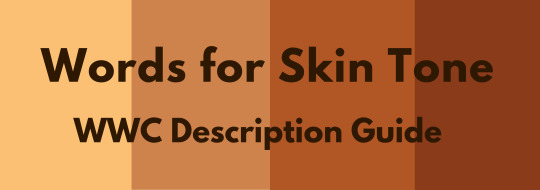
We discussed the issues describing People of Color by means of food in Part I of this guide, which brought rise to even more questions, mostly along the lines of “So, if food’s not an option, what can I use?” Well, I was just getting to that!
This final portion focuses on describing skin tone, with photo and passage examples provided throughout. I hope to cover everything from the use of straight-forward description to the more creatively-inclined, keeping in mind the questions we’ve received on this topic.
Standard Description
Basic Colors

Pictured above: Black, Brown, Beige, White, Pink.
“She had brown skin.”
This is a perfectly fine description that, while not providing the most detail, works well and will never become cliché.
Describing characters’ skin as simply brown or beige works on its own, though it’s not particularly telling just from the range in brown alone.
Complex Colors
These are more rarely used words that actually “mean” their color. Some of these have multiple meanings, so you’ll want to look into those to determine what other associations a word might have.

Pictured above: Umber, Sepia, Ochre, Russet, Terra-cotta, Gold, Tawny, Taupe, Khaki, Fawn.
Complex colors work well alone, though often pair well with a basic color in regards to narrowing down shade/tone.
For example: Golden brown, russet brown, tawny beige…
As some of these are on the “rare” side, sliding in a definition of the word within the sentence itself may help readers who are unfamiliar with the term visualize the color without seeking a dictionary.
“He was tall and slim, his skin a russet, reddish-brown.”
Comparisons to familiar colors or visuals are also helpful:
“His skin was an ochre color, much like the mellow-brown light that bathed the forest.”
Modifiers
Modifiers, often adjectives, make partial changes to a word.The following words are descriptors in reference to skin tone.
Dark - Deep - Rich - Cool
Warm - Medium - Tan
Fair - Light - Pale
Rich Black, Dark brown, Warm beige, Pale pink…
If you’re looking to get more specific than “brown,” modifiers narrow down shade further.
Keep in mind that these modifiers are not exactly colors.
As an already brown-skinned person, I get tan from a lot of sun and resultingly become a darker, deeper brown. I turn a pale, more yellow-brown in the winter.
While best used in combination with a color, I suppose words like “tan” “fair” and “light” do work alone; just note that tan is less likely to be taken for “naturally tan” and much more likely a tanned White person.
Calling someone “dark” as description on its own is offensive to some and also ambiguous. (See: Describing Skin as Dark)
Undertones
Undertones are the colors beneath the skin, seeing as skin isn’t just one even color but has more subdued tones within the dominating palette.
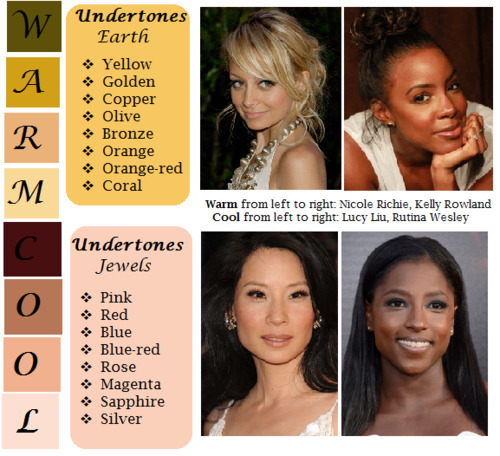
pictured above: warm / earth undertones: yellow, golden, copper, olive, bronze, orange, orange-red, coral | cool / jewel undertones: pink, red, blue, blue-red, rose, magenta, sapphire, silver.
Mentioning the undertones within a character’s skin is an even more precise way to denote skin tone.
As shown, there’s a difference between say, brown skin with warm orange-red undertones (Kelly Rowland) and brown skin with cool, jewel undertones (Rutina Wesley).
“A dazzling smile revealed the bronze glow at her cheeks.”
“He always looked as if he’d ran a mile, a constant tinge of pink under his tawny skin.”
Standard Description Passage
“Farah’s skin, always fawn, had burned and freckled under the summer’s sun. Even at the cusp of autumn, an uneven tan clung to her skin like burrs. So unlike the smooth, red-brown ochre of her mother, which the sun had richened to a blessing.”
-From my story “Where Summer Ends” featured in Strange Little Girls
Here the state of skin also gives insight on character.
Note my use of “fawn” in regards to multiple meaning and association. While fawn is a color, it’s also a small, timid deer, which describes this very traumatized character of mine perfectly.
Though I use standard descriptions of skin tone more in my writing, at the same time I’m no stranger to creative descriptions, and do enjoy the occasional artsy detail of a character.
Creative Description
Whether compared to night-cast rivers or day’s first light…I actually enjoy seeing Characters of Colors dressed in artful detail.
I’ve read loads of descriptions in my day of white characters and their “smooth rose-tinged ivory skin”, while the PoC, if there, are reduced to something from a candy bowl or a Starbucks drink, so to actually read of PoC described in lavish detail can be somewhat of a treat.
Still, be mindful when you get creative with your character descriptions. Too many frills can become purple-prose-like, so do what feels right for your writing when and where. Not every character or scene warrants a creative description, either. Especially if they’re not even a secondary character.
Using a combination of color descriptions from standard to creative is probably a better method than straight creative. But again, do what’s good for your tale.
Natural Settings - Sky
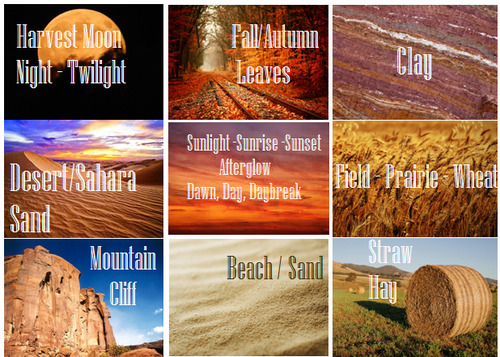
Pictured above: Harvest Moon -Twilight, Fall/Autumn Leaves, Clay, Desert/Sahara, Sunlight - Sunrise - Sunset - Afterglow - Dawn- Day- Daybreak, Field - Prairie - Wheat, Mountain/Cliff, Beach/Sand/Straw/Hay.
Now before you run off to compare your heroine’s skin to the harvest moon or a cliff side, think about the associations to your words.
When I think cliff, I think of jagged, perilous, rough. I hear sand and picture grainy, yet smooth. Calm. mellow.
So consider your character and what you see fit to compare them to.
Also consider whose perspective you’re describing them from. Someone describing a person they revere or admire may have a more pleasant, loftier description than someone who can’t stand the person.
“Her face was like the fire-gold glow of dawn, lifting my gaze, drawing me in.”
“She had a sandy complexion, smooth and tawny.”
Even creative descriptions tend to draw help from your standard words.
Flowers
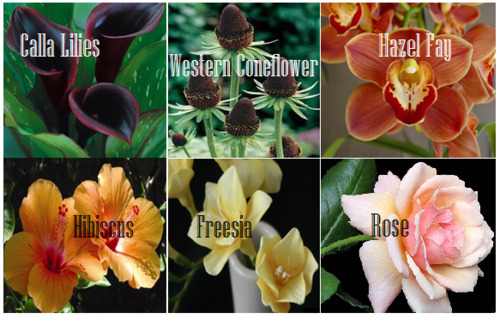
Pictured above: Calla lilies, Western Coneflower, Hazel Fay, Hibiscus, Freesia, Rose
It was a bit difficult to find flowers to my liking that didn’t have a 20 character name or wasn’t called something like “chocolate silk” so these are the finalists.
You’ll definitely want to avoid purple-prose here.
Also be aware of flowers that most might’ve never heard of. Roses are easy, as most know the look and coloring(s) of this plant. But Western coneflowers? Calla lilies? Maybe not so much.
“He entered the cottage in a huff, cheeks a blushing brown like the flowers Nana planted right under my window. Hazel Fay she called them, was it?”
Assorted Plants & Nature

Pictured above: Cattails, Seashell, Driftwood, Pinecone, Acorn, Amber
These ones are kinda odd. Perhaps because I’ve never seen these in comparison to skin tone, With the exception of amber.
At least they’re common enough that most may have an idea what you’re talking about at the mention of “pinecone.“
I suggest reading out your sentences aloud to get a better feel of how it’ll sounds.
“Auburn hair swept past pointed ears, set around a face like an acorn both in shape and shade.”
I pictured some tree-dwelling being or person from a fantasy world in this example, which makes the comparison more appropriate.
I don’t suggest using a comparison just “cuz you can” but actually being thoughtful about what you’re comparing your character to and how it applies to your character and/or setting.
Wood

Pictured above: Mahogany, Walnut, Chestnut, Golden Oak, Ash
Wood can be an iffy description for skin tone. Not only due to several of them having “foody” terminology within their names, but again, associations.
Some people would prefer not to compare/be compared to wood at all, so get opinions, try it aloud, and make sure it’s appropriate to the character if you do use it.
“The old warlock’s skin was a deep shade of mahogany, his stare serious and firm as it held mine.”
Metals

Pictured above: Platinum, Copper, Brass, Gold, Bronze
Copper skin, brass-colored skin, golden skin…
I’ve even heard variations of these used before by comparison to an object of the same properties/coloring, such as penny for copper.
These also work well with modifiers.
“The dress of fine white silks popped against the deep bronze of her skin.”
Gemstones - Minerals
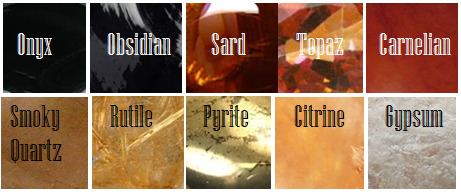
Pictured above: Onyx, Obsidian, Sard, Topaz, Carnelian, Smoky Quartz, Rutile, Pyrite, Citrine, Gypsum
These are trickier to use. As with some complex colors, the writer will have to get us to understand what most of these look like.
If you use these, or any more rare description, consider if it actually “fits” the book or scene.
Even if you’re able to get us to picture what “rutile” looks like, why are you using this description as opposed to something else? Have that answer for yourself.
“His skin reminded her of the topaz ring her father wore at his finger, a gleaming stone of brown, mellow facades.”
Physical Description
Physical character description can be more than skin tone.
Show us hair, eyes, noses, mouth, hands…body posture, body shape, skin texture… though not necessarily all of those nor at once.
Describing features also helps indicate race, especially if your character has some traits common within the race they are, such as afro hair to a Black character.
How comprehensive you decide to get is up to you. I wouldn’t overdo it and get specific to every mole and birthmark. Noting defining characteristics is good, though, like slightly spaced front teeth, curls that stay flopping in their face, hands freckled with sunspots…
General Tips
Indicate Race Early: I suggest indicators of race be made at the earliest convenience within the writing, with more hints threaded throughout here and there.
Get Creative On Your Own: Obviously, I couldn’t cover every proper color or comparison in which has been “approved” to use for your characters’ skin color, so it’s up to you to use discretion when seeking other ways and shades to describe skin tone.
Skin Color May Not Be Enough: Describing skin tone isn’t always enough to indicate someone’s ethnicity. As timeless cases with readers equating brown to “dark white” or something, more indicators of race may be needed.
Describe White characters and PoC Alike: You should describe the race and/or skin tone of your white characters just as you do your Characters of Color. If you don’t, you risk implying that White is the default human being and PoC are the “Other”).
PSA: Don’t use “Colored.” Based on some asks we’ve received using this word, I’d like to say that unless you or your character is a racist grandmama from the 1960s, do not call People of Color “colored” please.
Not Sure Where to Start? You really can’t go wrong using basic colors for your skin descriptions. It’s actually what many people prefer and works best for most writing. Personally, I tend to describe my characters using a combo of basic colors + modifiers, with mentions of undertones at times. I do like to veer into more creative descriptions on occasion.
Want some alternatives to “skin” or “skin color”? Try: Appearance, blend, blush, cast, coloring, complexion, flush, glow, hue, overtone, palette, pigmentation, rinse, shade, sheen, spectrum, tinge, tint, tone, undertone, value, wash.
Skin Tone Resources
List of Color Names
The Color Thesaurus
Skin Undertone & Color Matching
Tips and Words on Describing Skin
Photos: Undertones Described (Modifiers included)
Online Thesaurus (try colors, such as “red” & “brown”)
Don’t Call me Pastries: Creative Skin Tones w/ pics I
Writing & Description Guides
WWC Featured Description Posts
WWC Guide: Words to Describe Hair
Writing with Color: Description & Skin Color Tags
7 Offensive Mistakes Well-intentioned Writers Make
I tried to be as comprehensive as possible with this guide, but if you have a question regarding describing skin color that hasn’t been answered within part I or II of this guide, or have more questions after reading this post, feel free to ask!
~ Mod Colette
170K notes
·
View notes
Text
You bored, or feeling artsy but don’t have any inspiration...? *updated!*
Do you need to distract yourself? Or are you simply bored? Here are some great websites to make the time pass.
create pixel art
Awesome photo editor and art program, all free…!
Totally free transparent textures
make a cute chibi
draw some cool generative art
be a graffiti creator
create a picassohead (you don’t need to be a picasso to do so)
paint online
another awsome site to create pixel art on
and another one
create your own mandala
or color one
create an avatar
or you can try creating your own superhero
here you can interact with organisms in different environments to see how to music changes
here’s a website that translates the time into hexidecimal colours,
Here is a website where you can travel along a 3D line into the infinite unkown
here is a website where you can listen to rain with or without music
Need a model in a certain pose for drawing? here
Want to build your own planet
here is a website where you can create your own galaxies
make your own pattern (very useful if you need a new background)
create next hit comic
make a city which looks like something from 90′s games
draw a mandala like design
jig saw puzzles
more jig saw puzzles to solve
create a stunning HTML5 animation - no coding!
make a movie
create and dress up dolls
play a piano
you can also play a guitar
create sounds
another sound creator
create a logo
design your dream home
sketch rooms
explore fashion trends and create your own sets
build a website
try this app for building a website
Or maybe start learning how to code!
design your own t-shirt or a beanie or sweatpants and order them
design your own phone case
pretend to be a graphic designer with this cool online tool
Make your own Glitch art
Here’s another glitch art maker
And another!
Holy hell, here’s a third!
make an image look like it was created by a commodore 64
freaking cool text generator!
Easy to use word processor
Make up really cool patterns or run your photos through it :)
Write an essay on anything with no hassle
Wanna see how something you write would look like if it was on JacksFilms YGS((Your Grammar Sucks videos on YouTube))?
Make pictures out of text
ASCII word generator
Need an idea for some fanart-here :D
Still haven’t found something that would float your boat? Try these:
watch a documentary
learn to code
do something yourself
workout with the help of this great youtube channels
learn things
play pokemon or zelda or other awesome old school games
waste your time on miniclip
play games at additing games
or try games at agame
calm your thoughts
the quiet place
it will be okay
vent or listen to someone
pour out your soul
explore the sky
look at art from around the world
virtually visit museum of iraq
explore world with arounder
create a music playlist
list through rare books
scroll useful science website
create sand art
brain games
try out tastekid and discover new favorite band or movie or book
interactive 3D anatomy
random street view
post a secret
create a family tree
find our what’s the difference between x and y
help scientists and become volunteer researcher
create your own font
read a classic short story
In the mood to read, but not sure exactly what book to go for?
scribble on maps
listen to letters
play with acrobots
listen to podcasts
make a bucket list
Ever want to see the most truly useless websites in creation?
Prank a friend with this blue screen of death!
Zone out watching the colors drip down
Maybe none of these peeked your interest-maybe you’ve been wanting to create an o.c, but never really knew how to start-or you just enjoy making O.C’s….
This masterlist is to help you in making your own OCs….it can also apply to developing RP characters i suppose! (´ヮ`)!
How to Write Better OCs:
basic tips on how to make your oc even better
tragic backstory? learn how to write one/make yours great
writing specific characters
a wordier, great guide on how to develop your character
kick out those vague descriptions and make them AWESOME
Character Development:
how to actually make an OC
Q&A (to develop characters)
more Q&As
giving your character a backstory
how to write an attractive character
Need an Appearance idea?
Humanoid generator? check
Here’s another one
and maybe if you didn’t like those this’ll work
Need Monsterpeople?
Well, then here ya’ go
Maybe you need Cats?
Diversity
adding more racial diversity
avoiding tokenism, AKA, how to add diversity to your cast not just because you “need” it
writing sexuality and gender expression (doesnt include non binary, if you have a good ref to that, please add on!)
masterpost on writing more diversity into your story
cultures of the world
guides to drawing different ethnicities (not just a great art reference, but also really helpful in appearance descriptions!)
Mary Sue/Gary Stu
Test to see if your character is a Sue
Explains subdivisions of Sues/Stus
Powerful Characters Don’t Have to Be Sues
Villains
villain generator
need an evil sounding name for your evil character? bam
villain archetypes
what’s your villain’s motive for being a villain?
Relationships
character perceptions (What your character thinks of themselves and what others think of them)
how to write strong relationships between two characters
8 ways to write better characters and develop their relationships with others
OCxLove Interest Handbook
develop your couple with good ol’ Q&A!
how to write realistic relationships
how to write relatives for your characters (this is more OC related to a canon character, but will help in writing family members in general)
ARCHETYPES
12 common archetypes
8 archetypes for male/female characters
female archetypes (goes pretty indepth from two main categories)
a list of archetypes
NAMES
how to name your character
random name generator
most common surnames
surnames by ethnicity
APPEARANCE
tips for better design
basic appearance generator
pinterest board for character design (includes NSFW and images of skeletons/exposed muscle (?) so tread carefully!)
clothing ref masterpost
Clothing generator
Another clothing generator
More clothing generator
Aaaand even more
Steam punk clothing
Char Style preference
Dress Generator
DETAILS
give your character better powers
a list of professions
proactive vs reactive characters
positive and negative traits
interest generator
skills generator
motivation generator
123 ideas for character flaws
list of phobias
Oh shit someone died
Backgrounds and stuff? yep
Quirks
Personality. you need that shit
Need something fandom related?
City generator hell yeah
location? got ya
World-building?
make your own god damn laws
Landscape.
Need Item names?
Fantasy/sci-fi/etc. medicine names
Stuff to make things more interesting.Weapons, clothes, treasures… whatever your characters need.
Item & Artifact Generators
Other stuffs!
Genre, Plot, & Story Prompt Generators
How did your characters meet?
Fanfic plots. you bet your ass.
401K notes
·
View notes
Text
It is increasingly obvious that most people have no idea how to indicate an illness is slowly killing someone without making them cough up blood. Doesn’t matter what it is or if it has anything to do with your respiratory system, if you’re dying, you’re coughing up blood.
110K notes
·
View notes
Text
Words to describe facial expressions
Absent: preoccupied
Agonized: as if in pain or tormented
Alluring: attractive, in the sense of arousing desire
Appealing: attractive, in the sense of encouraging goodwill and/or interest
Beatific: blissful
Black: angry or sad, or hostile
Bleak: hopeless
Blinking: surprise, or lack of concern
Blithe: carefree, lighthearted, or heedlessly indifferent
Brooding: anxious and gloomy
Bug eyed: frightened or surprised
Chagrined: humiliated or disappointed
Cheeky: cocky, insolent
Cheerless: sad
Choleric: hot-tempered, irate
Darkly: with depressed or malevolent feelings
Deadpan: expressionless, to conceal emotion or heighten humor
Despondent: depressed or discouraged
Doleful: sad or afflicted
Dour: stern or obstinate
Dreamy: distracted by daydreaming or fantasizing
Ecstatic: delighted or entranced
Faint: cowardly, weak, or barely perceptible
Fixed: concentrated or immobile
Gazing: staring intently
Glancing: staring briefly as if curious but evasive
Glazed: expressionless due to fatigue or confusion
Grim: fatalistic or pessimistic
Grave: serious, expressing emotion due to loss or sadness
Haunted: frightened, worried, or guilty
Hopeless: depressed by a lack of encouragement or optimism
Hostile: aggressively angry, intimidating, or resistant
Hunted: tense as if worried about pursuit
Jeering: insulting or mocking
Languid: lazy or weak
Leering: sexually suggestive
Mild: easygoing
Mischievous: annoyingly or maliciously playful
Pained: affected with discomfort or pain
Peering: with curiosity or suspicion
Peeved: annoyed
Pleading: seeking apology or assistance
Quizzical: questioning or confused
Radiant: bright, happy
Sanguine: bloodthirsty, confident
Sardonic: mocking
Sour: unpleasant
Sullen: resentful
Vacant: blank or stupid looking
Wan: pale, sickly
Wary: cautious or cunning
Wide eyed: frightened or surprised
Withering: devastating
Wrathful: indignant or vengeful
Wry: twisted or crooked to express cleverness or a dark or ironic feeling
104K notes
·
View notes
Photo
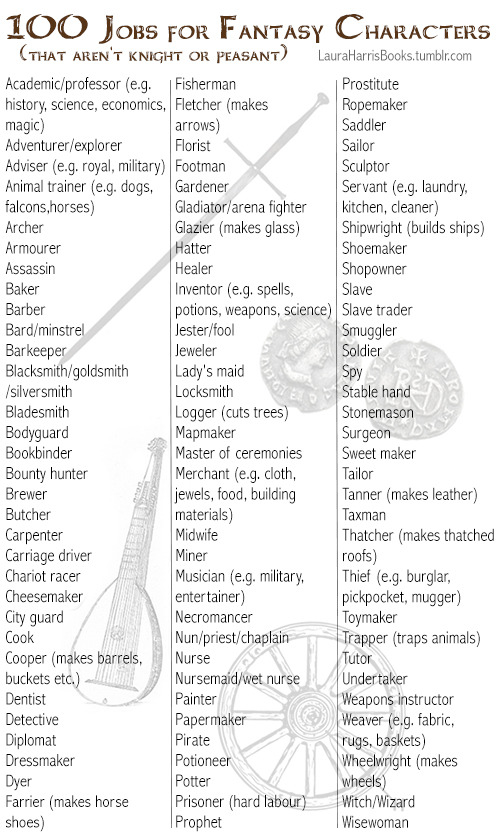
Beyond this, consider how these professions might vary depending on who the customers are - nobles, or lower class. Are they good at their job or just scraping by? Do they work with lots of other people or on their own? City or village?
For younger characters:
Apprentice to any of the above
Messenger/runner
Page/squire
Pickpocket
Shop assistant
Student
Looks after younger siblings
(Images all from Wikimedia Commons)
207K notes
·
View notes
Text
The whole “how the hell does this predatory creature get enough sustenance” thing that plagues fantasy and sci-fi occasionally gets so absurd it loops around into being funny, like the scene in Star Wars when the Millenium Falcon is flying through an asteroid field and gets swallowed by a worm.
I could complain about that, but I could also conclude that the supply of reckless space pilots flying into asteroid fields has been consistent enough for the past few million years for animals to evolve to prey upon them.
64K notes
·
View notes
Text
You know how fantasy worlds are almost always based on (mostly Central and Northern) European Medieval aesthetic and folklore?
For a while I’ve been thinking that if we had a fantasy world made here, it would be interesting to have it be inspired by Modernisme (the Catalan artistic movement from the late 19th century - early 20th century). I mean, look at this and tell me it doesn’t have potential:
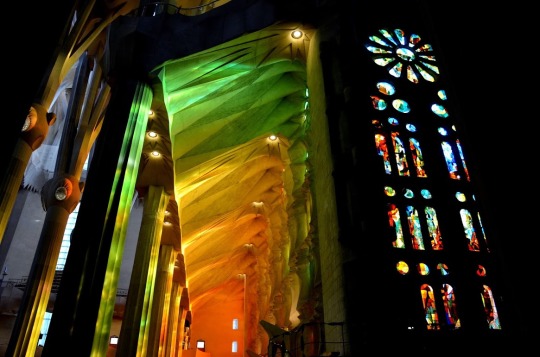
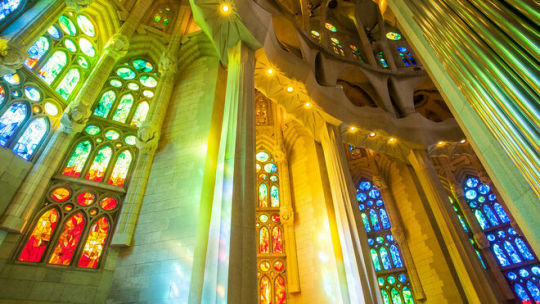
Interior of the Sagrada Família basilica, Barcelona. The stained glass in different sides of the temple are different colours, so the light changes colour depending on the hour of the day. (Photo sources x x)
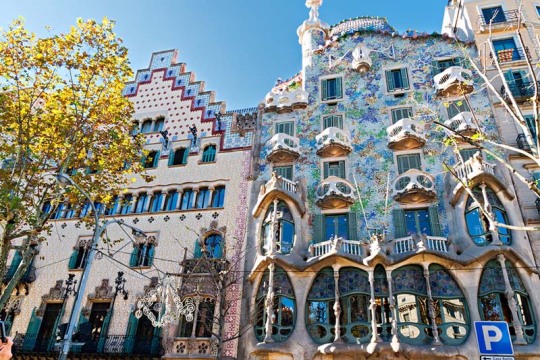
Illa de la Discòrdia, Barcelona. x
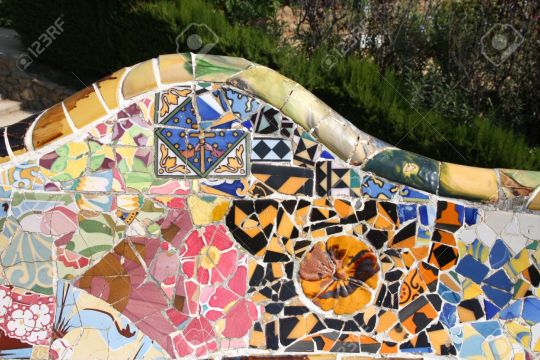

Benches in Parc Güell (Barcelona), made with the “trencadís”, the typical mosaic used in many of Antoni Gaudí’s works (he’s one of the most famous Modernist architects, and one of the most famous Catalan architects of all times too). x
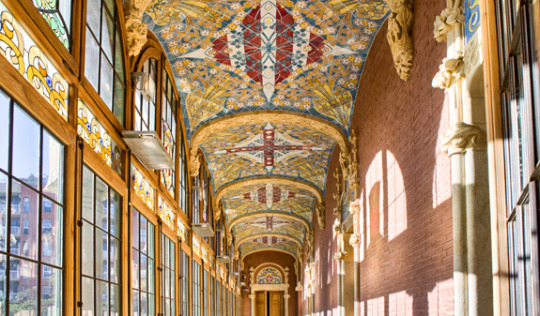
A hall in Hospital de Sant Pau, Barcelona. x
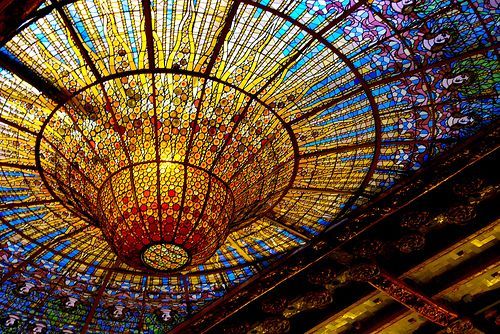
Ceiling of Palau de la Música Catalana, a concert hall in Barcelona.

Lots of these things. This one is in Argentona (Catalonia, too). x
And fashion would be like this:
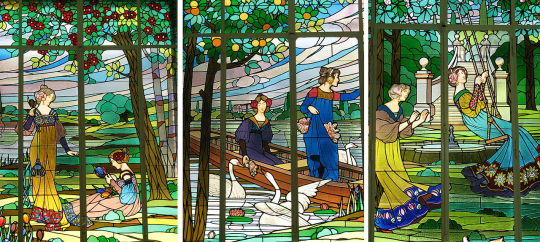
Stained glass in Cerdanyola, Catalonia. x
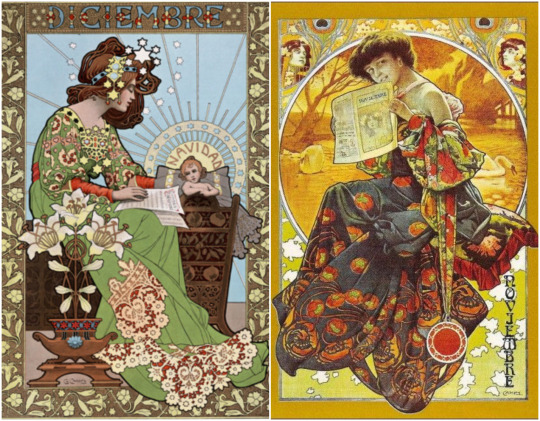
Illustrations by Gaspar Camps.
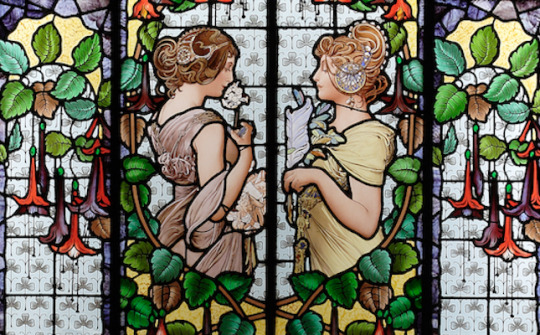
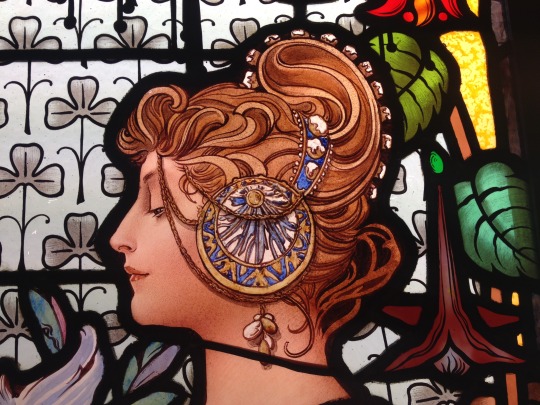
More stained glass, now in Museu del Modernisme, Barcelona. x

Modernist jewels by Lluís Masriera (I’ve talked about Modernist jewels in this previous post). x
Even the furniture:
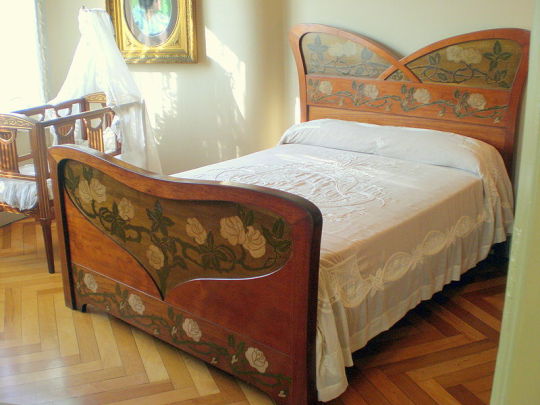
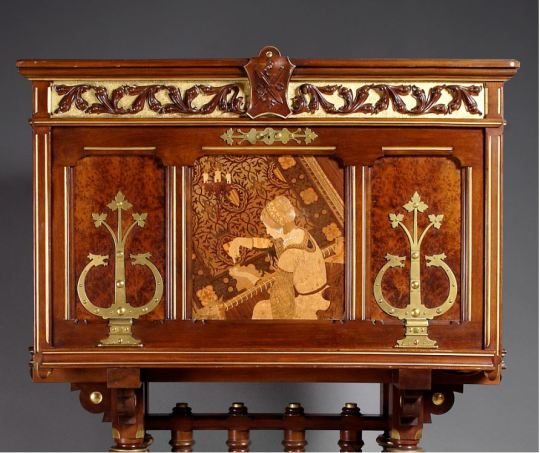
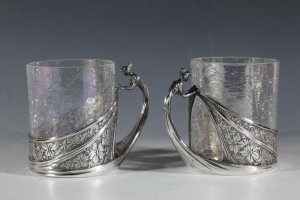
x
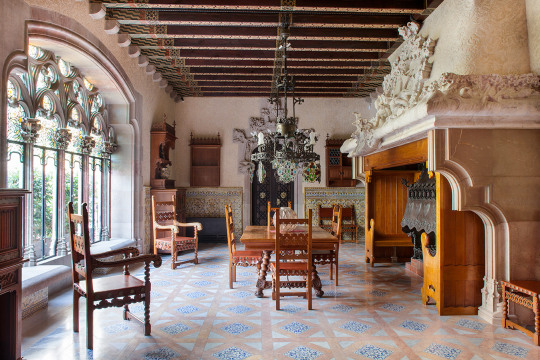
Interior of Casa Amatller in Barcelona. x.
Even in wood looked pretty.
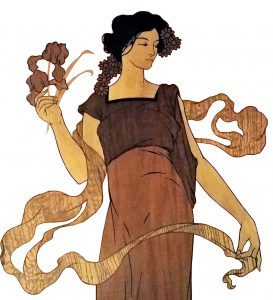
x
And lots of cool windows inspired by nature!
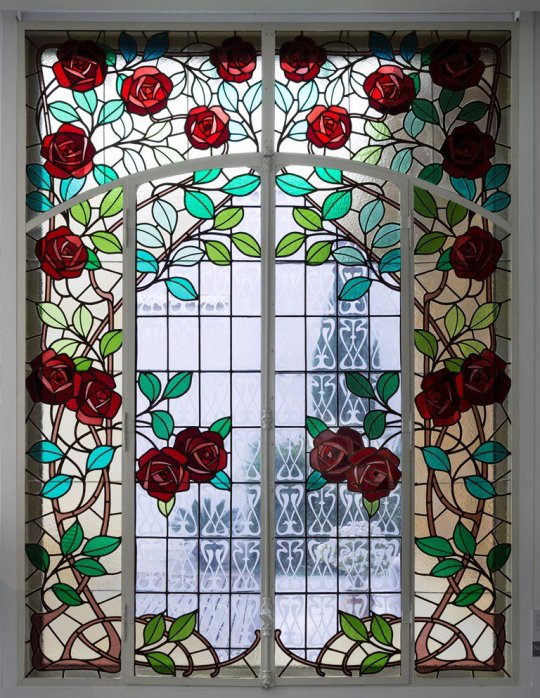
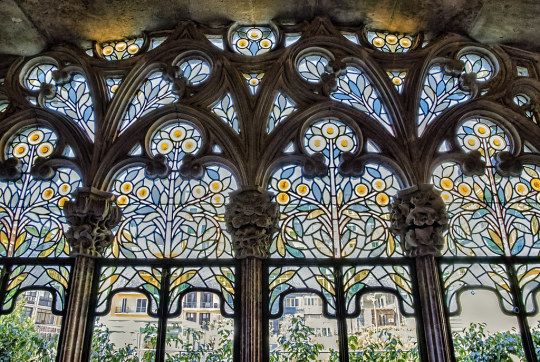
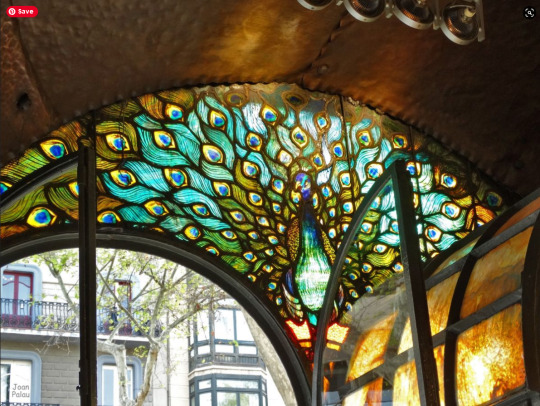

And from outside
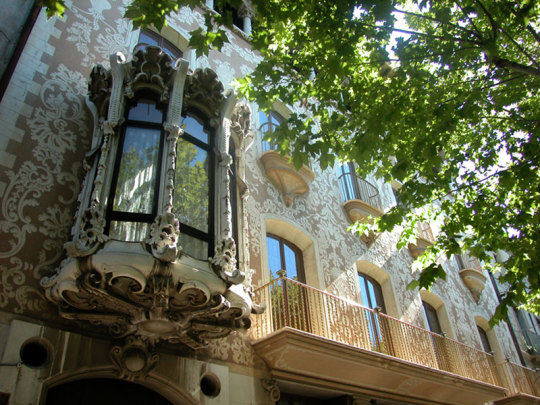
Olot, Catalonia. x.
And of course all kinds of windows. Light is important!
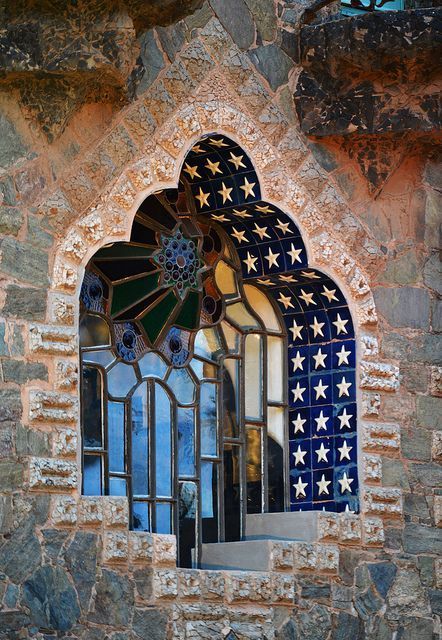
Torre Bellesguard. x.
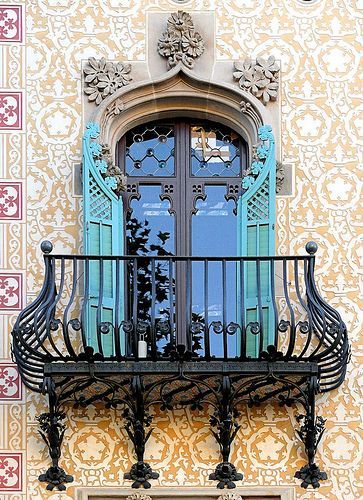
Barcelona. x.
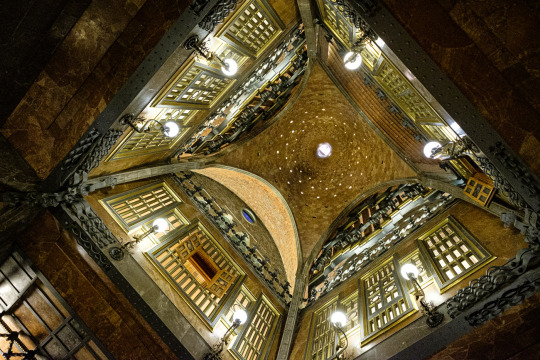
This ceiling in Palau Güell with holes to let light in. x.
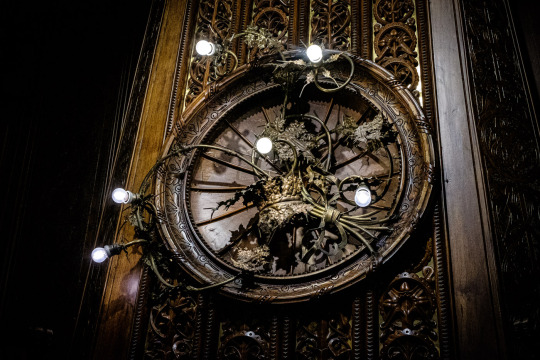
And this lamp?? Also in Palau Güell. x.
Everything would have to be very curvy.
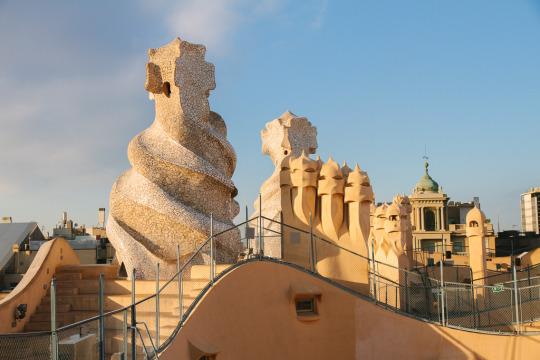
Casa Milà, Barcelona. x.
And shops
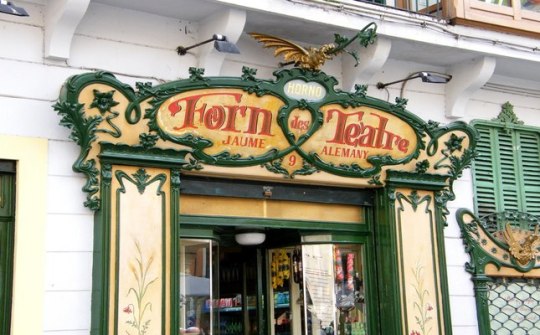
This bakery in Palma, Mallorca. x.
And I won’t begin with the tiles to not make the post longer…
What do you think?
And for people from other countries, what element in your culture do you think a fantasy world could be based on, aesthetically?
34K notes
·
View notes
Note
Hey Neil! Do you have any advice for aspiring authors around dealing with tropes? I'm writing something but at times it feels like everything is too trope-y. I don't want to go against the tropes though just for the sake of it! Cheers - A very self critical writer
I kind of wish that the whole "TV tropes" thing had never happened, to be honest. As far as I'm concerned it's like a website that analyses word use or letter of the alphabet use, with the additional function of making people self-conscious.
There aren't a lot of story shapes. In a love story, people get to meet. Either they meet dramatically or they meet in a way that is interesting by being undramatic. Either they fall for each other or they don't, or one falls but the other doesn't. Something had better prevent them from getting together, whether it's pride or a guard with a gun, because otherwise you don't have a plot, unless they get together and then something goes wrong... and on and on. Everything is going to be some kind of trope, and none of that actually matters. What matters is the story. Pretend you've never heard of tropes.
Tell your story. Tell it new, tell it freshly, have fun telling it. Make characters we care about, give them interesting problems to solve, sort it out in the end or at least make the ending, whether happy or sad, feel satisfying, and you'll be fine.
11K notes
·
View notes

